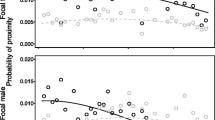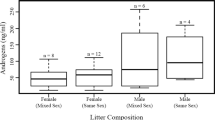Abstract
We report here that in a large captive group of monkeys, Macaca mulatta,sudden sex-related changes occur in social interactions in one short phase of an infant’s development. Social interactions of 1-year-old animals (males, N =12; females, N =8) 6 weeks before the birth of siblings were compared with interactions occurring 6 weeks after the birth. On the day of the siblings’ birth, depression-like postures were seen in two yearling males (YMs); 10 YMs showed hyperactivity. In the postbirth period, YMs refocused their attentions away from their mother and toward other, often unrelated members of the group. Although YMs initiated disengagement of interactions with their mothers, there was evidence that mothers attempted to lessen this disengagement. The YMs had close relationships with specific (“preferred”) male individuals. These relationships (particularly those with adult males) became more pronounced following the birth of the sibling. The adult-male group also took an active role in maintaining interactions with YMs. The preferred partners in the YM-other male relationship before the birth of the sibling were, however, not always the same as those in the period after the birth. Dominance relationships and probably genetic factors determined patterns of interaction between YMs and their preferred male partners. Among yearling females (YFs), no dramatic changes in interactions with their mothers or with other group members were detected after their mothers gave birth. Relationships in YF-mother and YF-other-individual pairs (especially when the other individual was kin) seemed to be consolidated during the postbirth interval. There was little evidence of jealousy between the YFs and their younger siblings. Thus, sibling birth acted as a stimulus for the occurrence of sexually dimorphic interactions in yearlings. We suggest that in natural environments, social interactions in YFs promote relationships that will serve to integrate them into the matrilineal social structure, whereas comparable behavior in YMs encourages relationships with males that they may emigrate with into, or meet again in, nonnatal troops.
Similar content being viewed by others
References
Altmann, J. (1980).Baboon Mothers and Infants, Harvard University Press, Cambridge, Mass.
Berman, C. M. (1978). Analysis of mother-infant interactions in groups: Possible influences of yearling siblings. In Chivers, D. J., and Herbert, J. (eds.),Recent Advances in Primatology, Academic Press, London, Vol. 1, pp. 111–113.
Berman, C. M. (1982a). The ontogeny of social relationships with group companions among free-ranging infant rhesus monkeys. II. Differentiation and attractiveness.Anim. Behav. 30: 163–170.
Berman, C. M. (1982b). The social development of an orphaned rhesus infant on Cayo Santiago: Male care, foster mother-orphan interaction and peer interaction.Am. J. Primatol. 3: 131–141.
Berman, C. M. (1983). Effects of being orphaned: A detailed case study of an infant rhesus. In Hinde, R. A. (ed.),Primate Social Relationships: An Integrated Approach, Blackwell, Oxford, pp. 79–81.
Blaffer-Hrdy, S. (1976). Care and exploitation of nonhuman primate infants by conspecifics other than the mother. In Rosenblatt, J. S., Hinde, R. A., Shaw, E., and Beer, C. (eds.),Advances in the Study of Behavior, Academic Press, New York, Vol. 6, pp. 101–158.
Bolwig, N. (1980). Early social development and emancipation ofMacaca nemestrina and species ofPapio.Primates 21: 357–375.
Colvin, J. (1983). Influences of the social situation on male emigration. In Hinde, R. A. (ed.),Primate Social Relationships: An Integrated Approach, Blackwell, Oxford, pp. 160–171.
Colvin, J. (1985). Breeding-season relationships of immature male rhesus monkeys with females. I. Individual differences and constraints on partner choice.Int. J. Primatol. 6: 261–287.
Colvin, J., and Tissier, G. (1985). Affiliation and reciprocity in sibling and peer relationships among free-ranging immature male rhesus monkeys.Anim. Behav. 33: 959–977.
DeVore, I. (1963). Mother-infant relations in free-ranging baboons. In Rheingold, H. L. (ed.),Maternal Behavior in Mammals, Wiley, New York and London, pp. 305–335.
DeWaal, F. B. M. (1968). Class structure in a rhesus monkey group: The interplay between dominance and tolerance.Anim. Behav. 34: 1033–1040.
Dunn, J. (1983). Sibling relationships in early childhood.Child Dev. 54: 787–811.
Dunn, J., and Kendrick, C. (1982).Siblings: Love, Envy, and Understanding, Harvard University Press, Cambridge, Mass.
Harlow, H. R., Harlow, M. K., and Hansen, E. W. (1963). The maternal affectional system of rhesus monkeys. In Rheingold, H. L. (ed.),Maternal Behavior in Mammals, Wiley, New York and London, pp. 254–281.
Hinde, R. A. (1979).Towards Understanding Relationships, Academic Press, London.
Hinde, R. A., and Atkinson, S. (1970). Assessing the roles of social partners in maintaining mutual proximity, as exemplified by mother-infant relations in rhesus monkeys.Anim. Behav. 18: 169–176.
Hinde, R. A., and McGinnis, L. (1977). Some factors influencing the effects of temporary mother-infant separation: some experiments with rhesus monkeys.Psychol. Med. 7: 197–212.
Hinde, R. A., and Spencer-Booth, Y. (1968). The study of mother-infant interaction in captive group-living rhesus monkeys.Proc. Roy. Soc. B. 169: 177–201.
Hinde, R. A., and Spencer-Booth, Y. (1971). Towards understanding individual differences in rhesus mother-infant interactions.Anim. Behav. 19: 165–173.
Holman, S. D., and Goy, R. W. (1980). Behavioral and mammary responses of adult female rhesus to strange infants.Horm. Behav. 14: 348–357.
Hooley, J. M., and Simpson, M. (1983). Influences of siblings on the infant’s relationship with the mother and others. In Hinde, R. A. (ed.),Primate Social Relationships: An Integrated Approach, Blackwell, Oxford, pp. 139–142.
Kaufman, I. C. (1974). Mother/infant relations in monkeys and humans: a reply to Professor Hinde. In White, N. F. (ed.),Ethology and Psychiatry, University of Toronto Press, Toronto, pp. 47–68.
Lee, P. C. (1983a). Effects of parturition on the mother’s relationship with older offspring. In Hinde, R. A. (ed.),Primate Social Relationships: An Integrated Approach, Blackwell, Oxford, pp. 134–138.
Lee, P. C. (1983b). Effects of the loss of the mother on social development. In Hinde, R. A. (ed.),Primate Social Relationships: An Integrated Approach, Blackwell, Oxford, pp. 73–79.
Locke-Haydon, J., and Chalmers, N. R. (1983). The development of infant-caregiver relationships in captive common marmosets (Callithrix jacchus).Int. J. Primatol. 4: 63–81.
McKenna, J. J. (1979). Aspects of infant socialization, attachment, and maternal caregiving patterns among primates: A cross-disciplinary review.Yb. phys. Anthrop. 22: 250–286.
Mineka, S., and Suomi, S. J. (1978). Social separation in monkeys.Psychol. Bull. 85:1376–1400.
Quiatt, D. (1979). Aunts and mothers: Adaptive implications of allomaternal behavior of non-human primates.Am. Anthrop. 81: 310–319.
Rowell, T. (1972).Social Behaviour of Monkeys, Penguin, Harmondworth.
Southwick, C. H., Beg, M. A., and Siddiqi, M. A. (1961). A population survey of rhesus monekys in Northern India. II. Transportation routes and forest areas.Ecology 42: 698–710.
Spencer-Booth, Y. (1968). The behaviour of group companions towards monkey infants.Anim. Behav. 16: 541–557.
Spencer-Booth, Y., and Hinde, R. A. (1967). The effects of separating rhesus infants from their mothers for six days.J. Child Psychol. Psychiat. 7: 179–197.
Weisbard, C., and Goy, R. W. (1976). Effect of parturition and group composition on competitive drinking order in stumptail macaques (Macaca arctoides).Folia primatol. 25: 95–121.
White, L. E., and Hinde, R. A. (1975). Some factors affecting mother-infant relations in rhesus monkeys.Anim. Behav. 23: 527–542.
Author information
Authors and Affiliations
Rights and permissions
About this article
Cite this article
Holman, S.D., Goy, R.W. Sexually dimorphic transitions revealed in the relationships of yearling rhesus monkeys following the birth of siblings. Int J Primatol 9, 113–133 (1988). https://doi.org/10.1007/BF02735732
Received:
Revised:
Issue Date:
DOI: https://doi.org/10.1007/BF02735732




